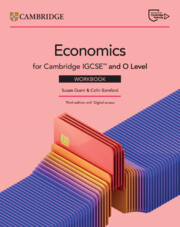Cambridge IGCSE™ and O Level Economics Workbook with Digital Access (2 Years)
Overview
This print and digital workbook provides additional exercises and practice questions to enable students to develop their skills. The activities in this resource can be used in class as further practice tasks or outside the classroom as homework. It follows the same chapter structure as the coursebook and teacher's resource, so you can confidently use it to support the content of your lessons. Activities gradually increase in difficulty to support students as they progress through the course, focusing on key skills including knowledge, evaluation and analysis. This workbook supports the Cambridge IGCSE™ , IGCSE (9-1) and O Level Economics syllabuses (0455/0987/2281) for examination from 2027. Answers to activities are available to teachers via Cambridge GO.
Features
- Key skills activities support students as they progress through the course, with multiple stages focusing on a variety of skills including knowledge, evaluation and analysis.
- Practice questions enable students to practice what they have covered in each topic and prepare for assessment.
- Worked examples provide students with sample answers to help them understand how to approach each question.
- 'Improve this answer' exercises encourage students to assess an example answer and apply improvements to their own answers.
- Learning intentions at the start of each chapter provide students with a clear focus to support their learning.
- Key terms are highlighted in each chapter.
- Tips are included throughout the workbook to provide additional support for students.
- Includes answers to the exercises and practice questions in this resource.
Contents
- How to use this book
- Introduction
- Developing Skills
- Section 1. The basic economic problem
- Chapter 1. The nature of the economic problem
- Chapter 2. Factors of production
- Chapter 3. Opportunity cost
- Chapter 4. Production possibility curve diagrams
- End of section 1 practice questions
- Section 2. The allocation of resources
- Chapter 5. The role of markets in allocating resources
- Chapter 6. Demand
- Chapter 7. Supply
- Chapter 8. Price determination
- Chapter 9. Price changes
- Chapter 10 Price elasticity of demand (PED)
- Chapter 11. Price elasticity of supply (PES)
- Chapter 12. Market economic system
- Chapter 13. Market failure
- Chapter 14. Mixed economic system
- End of section 1 practice questions
- Section 2. Section 3. Microeconomic decision makers
- Chapter 15. Money and banking
- Chapter 16. Households
- Chapter 17. Workers
- Chapter 18. Firms
- Chapter 19. Firms and production
- Chapter 20. Firms??? costs, revenue and objectives
- Chapter 21. Types of markets
- End of Section 3 practice question
- Section 4. Government and the macroeconomy
- Chapter 22. Government macroeconomic intervention
- Chapter 23. Fiscal policy
- Chapter 24. Monetary policy
- Chapter 25. Supply-side policy
- Chapter 26. Economic growth
- Chapter 27. Employment and unemployment
- Chapter 28. Inflation and deflation
- End of section 5 practice questions
- Section 5. Economic development
- Chapter 29. Living standards
- Chapter 30. Poverty
- Chapter 31. Population
- Chapter 32. Differences in economic development between countries
- End of section 5 practice questions
- Section 6. International trade and globalisation
- Chapter 33. Specialisation and free trade
- Chapter 34. Globalisation and trade restrictions
- Chapter 35. Foreign exchange rates
- Chapter 39. Current account balance of payments
- End of section 6 practice questions.
Brighter Thinking Blog
Keep up to date with the latest classroom tips and educational trends from our brighter thinkers.
Visit the blogCatalogues and Ordering
Looking for something in particular or just browsing? View our catalogues to see our full range of print and digital books.
View and downloadAdvice on useful tools
Advice on useful tools, activities and timetabling from teachers experiencing school closures.
Cambridge GO
All our supporting resources have now moved to Cambridge GO – the new home for your Cambridge digital content.
Listen to our podcast
Listen to our podcast to discover teaching inspiration & advice from leading educational thinkers.






